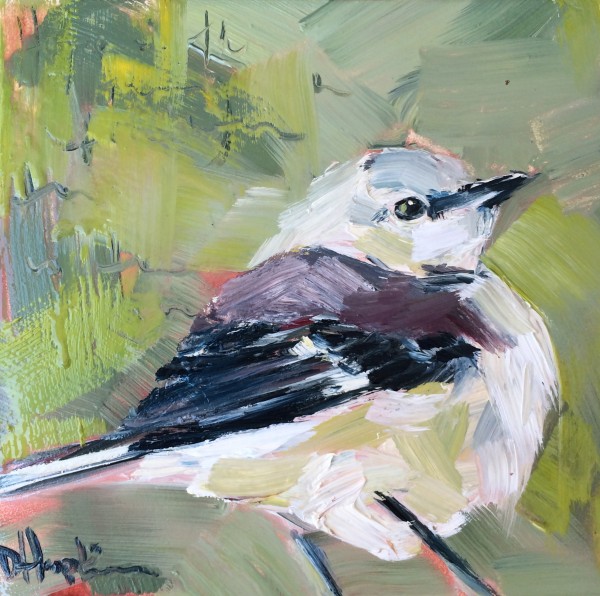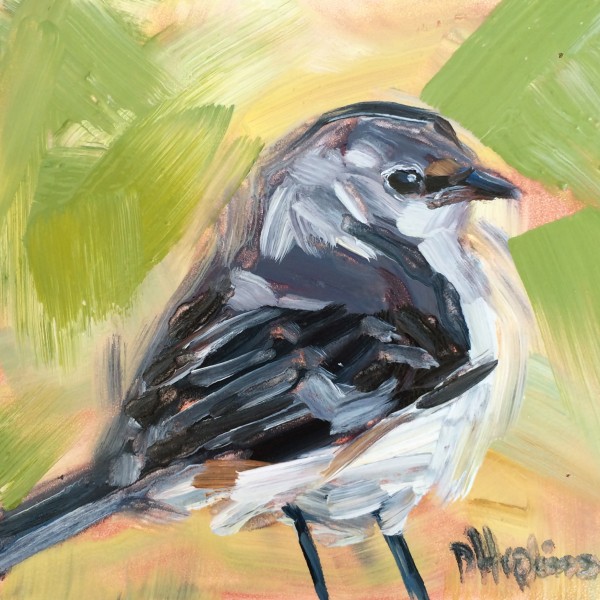Always Sketch First and Never Say Always
Home > Always Sketch First and Never Say Always
Mockingbird 1, 6×6, oil on gessoboard, $75 [button link=”http://www.dailypaintworks.com/fineart/denise-hopkins/mockingbird-1/239229″ type=”big”] Buy Now[/button] SOLD
Mockingbird 2, 6×6, oil on gessoboard, [button link=”http://www.dailypaintworks.com/fineart/denise-hopkins/mockingbird-2/239231″ type=”big”] Buy Now[/button] SOLD
Hemingway wrote that writing is easy, you just sit at a typewriter and bleed. Painting is easy too.
I’ve been away for a while. Not actually away, but away from the computer and in front of the easel working on a particularly difficult commissioned painting that just wasn’t going where I wanted it to.
In my head it was glorious. Brillant. If it never leaves your head, it can stay that way, which is why art is a scary, frustrating enterprise. The inevitable always happens, my reach exceeds my grasp.
I started over three times and by the third time, I realized I was over-thinking, over-working, fighting my canvas instead of leading it in a dance.
I rarely sketch first when I work on my small panels, but larger pieces require more preparation. In my excitement to complete the piece I forgot to plan it thoroughly. The second attempt included a sketch. But what good is a sketch if you start the painting before you’ve really mastered the composition?
My students often hated the thumbnails I made them do before a larger, graded piece and I, the boss, insisted on their importance and value both of which I’ve seemed to have completely disregarded in my own studio.
I’ll post a picture of the final piece soon. Very soon. But until then I’ll say I’ve re-learned the value of sketching and doing value studies before taking on a large work. I’ve learned how to communicate better with the client, what I’ll do differently the next time I take on a commission.
I’m going to sketch more. I’m going to do more value studies. I’m going to plan. But I’m still not willing to make it a hard fast rule. I’m in love with the spontenaity of some of my smaller pieces, the intuitive process, feeling around in the dark which feels more like discovery and less like bleeding. And, let’s be honest, painting for oneself is a far, far different experience than painting for someone else. By my third attempt at the painting I was finally able to mesh together the two– find a rhythm in what the client wanted and who I am, what I want, out of painting.
Which is what happened during today’s bird painting. I got a request to paint a mockingbird from a friend of a friend who wrote to me that although they are not the most beautiful birds, they are a reminder to her of God’s presence. I’m going to do a couple more, but in this one I wanted to do two things:
1. I always start by painting the entire panel a solid color, getting rid of the white and giving me a wet surface on which to place an image. Usually the entire original color gets covered by the painting’s end. For this painting, I wanted to allow some of that original color to show through. To not completely paint over it.
2. I wanted to use fewer strokes. On an interview on what is fast becoming my favorite art podcast (the savvy painter) there was a discussion about experienced artists using far fewer strokes on a painting. The novice paints and paints. The master looks, and looks. The master’s strokes are more thoughtful, poignant. I’m no master but the message resonated with me and what better way to become a master than to imitate one?
I’m happy with the results. The rusty pink under layer showing through the greens and around the bird. The deliberate, bold brushstrokes that suggest rather than define.
……………
I did the second mockingbird painting after I wrote this post. I think I’ll give every painting two go rounds from now on. You just can’t get it in one take.
Denise Hopkins
June 20, 2014
Share Post
blog
Related Blog Posts
Art/Poetry Spotlight: “Fire Kindled Before you were Born”
Fire Kindled Before you were Born, 6×6, oil on canvas Last month, the gallery hosted our first ever poetry night....
🎨 A Father’s Day Gift Guide for Every Kind of Dad (Featuring Fine Art Prints!)
Father’s Day is in a few short weeks. Celebrate the dad in your life with art this year! He has...
New Bird Minis Preview– May 2025!
9 new bird minis will be available first to my VIPS at 8am on May 3 2025. They will all be...

Join the Denise Hopkins Fine Art VIP Club Today
Become a member and enjoy early access to new releases, exclusive discounts, and a new wallpaper for your computer or tablet. Elevate your art journey with us.






One Response
I love the mockingbirds you did for “a friend of a friend “. I love your honesty and raw communication. I love that God gave you such talent. I love your courage. In short…you are a treasure.